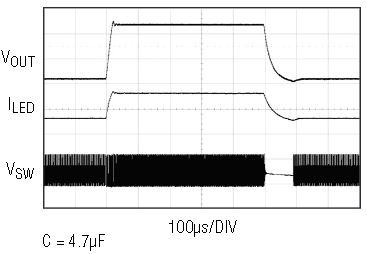No PWM Signal Needed for Accurate Dim/Bright Control of Automotive Brake Lights and Other Signal LEDs
No PWM Signal Needed for Accurate Dim/Bright Control of Automotive Brake Lights and Other Signal LEDs
著者
Bill Martin
2008年06月01日
Introduction
LEDs are quickly becoming standard lighting for a variety of commercial, automotive, and industrial applications. Some of these applications require wide-range brightness control, spurring a demand for products that offer PWM-based LED brightness control. However, many applications only require two settings, bright and dim, so generating a PWM signal for a binary choice is inconvenient overkill. The LT3592 LED driver is the solution to this problem. It simplifies design by offering two LED current settings with a 10:1 ratio, selected via a simple digital control pin. This pin has a low threshold voltage, but high voltage capability, making it very easy to plug into any automotive or industrial system. For an application such as automotive brake light control, the LT3592’s accurate, consistent output current levels and easy to use small package make it a perfect fit. Furthermore, the LT3592 is rugged enough to tolerate a 36V maximum input, making it useful in a wide variety of higher voltage applications.

Figure 1. Two red LED application with no external boost diode.
Simple 2-Level Current Control
The LT3592 uses a single external current sense resistor between the CAP and OUT pins to set its two output current levels, which have a 10:1 ratio. In bright mode, an internal amplifier regulates the voltage difference between CAP and OUT to 200mV. In dim mode, the voltage is regulated to 20mV. Using a 0.4Ω current sense resistor results in a bright current of 500mA and a DIM current of 50mA. Switching between the high and low current levels couldn’t be easier—bring the BRIGHT pin above 1.4V for high current, and below 0.3V for low current. The bright current level can be as high as 500mA.
The output voltage of the LT3592 can be as high as 20V, but the part is also designed to work well with single red LEDs, which can have forward voltages below 2V at reasonable current levels. The operating frequency can be set anywhere between 400kHz and 2.2MHz using a single resistor from the RT pin to ground. Set a lower operating frequency for the best efficiency, and a higher frequency for smaller filter components and overall solution size. The LT3592 also incorporates an internal Schottky diode between CAP and BOOST, which saves an external component for applications with two or more series LEDs (see Figure 2 for a single LED solution).

Figure 2. Single red LED application with external boost diode to VIN.
Rugged Solution for Tough Environments
In addition to an internal switch current limit circuit, the LT3592 includes a catch diode current sense limit function that protects the circuit during start-up at high input voltages. Simply connect the anode of the Schottky catch diode to the DA pin, and the LT3592 automatically reduces the oscillator frequency when the catch diode current is higher than 1A. The lower operating frequency prevents the inductor current from ramping up in an uncontrolled fashion and allows the switch current limit to be effective by avoiding minimum on time restrictions. The LT3592 also automatically reduces its operating frequency if the LED string shorts out, minimizing power dissipation in the part.
The SHDN and BRIGHT pins are as rugged as the VIN pin and can withstand up to 36V, so they can be tied to the input voltage. Nevertheless, both pins have low voltage thresholds that allow them to be directly interfaced to low voltage microcontrollers.

Figure 3. Efficiency for Figure 1.

Figure 4. Switching between dim (50mA) and bright (500mA) modes with 4.7μF output cap.
The LT3592 is not only useful for LED applications. It has a fully functional voltage control loop, and the current loop can be used as an accurate current clamp for voltage output applications. The voltage loop is also useful as a voltage clamp in case of an open LED fault. The transition between voltage and current control is stable and seamless.

Figure 5. A 5V power supply with a 500mA current limit.
Conclusion
The LT3592 makes 2-state bright/dim LED control simple and rugged. It is an ideal solution for applications such as automotive brake lights and flashing warning lights in industrial systems. Accurate control of the current levels makes LED brightness consistent across units in a given application regardless of varying LED forward voltage characteristics. Switching between the two current levels can be accomplished with either very low or very high voltage level digital signals.




















